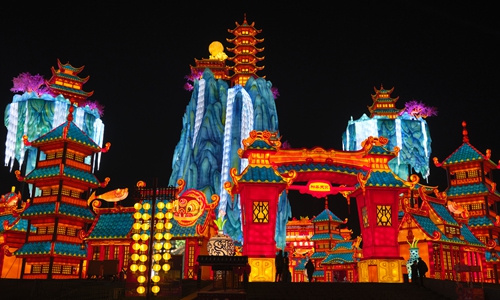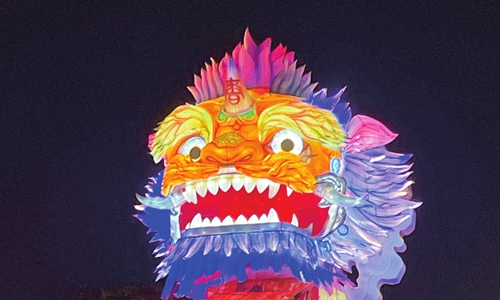
Lanterns inspired by ancient architecture on display at the 30th Zigong lantern festival held in Zigong, Southwest China's Sichuan Province Photo: VCG
Have you ever thought about transforming your drawings into lanterns? That's easily achieved by craftsmen in the city of Zigong, Southwest China's Sichuan Province.
Every year, the organizers of the Zigong lantern festival invite children aged from 4 to 14 to submit their drawings to be transformed into real lanterns. Local media outlets reported that a total of 208 drawings selected from more than 3,000 submissions were made into lanterns this year.
The drawing-turned-lanterns are just part of the magnificent colored lantern fest in the city.
Every Chinese Lunar New Year, the city brings up some giant and mesmerizing lanterns that transform the city into a luminous wonderland with intricate lanterns casting technicolor rays of light.
A 'young' cityDespite its modest size, Zigong, a city formerly known for salt production, now boasts lanterns as its new claim to fame, by combining its rich cultural heritage with its industrial past.
Established in 1939, Zigong was named after its two prominent salt wells Ziliujing and Gongjing in the region. The city was once a major salt producer in the region.
The roots of Zigong's affinity for lanterns stretch back to Tang Dynasty (618-907), but it was not until 1964 that the modern city truly embraced this luminous tradition.
Over the years, Zigong's fortunes ebbed and flowed, shaped by the rise and fall of its salt industry and the changing tides of economic development.
However, it was the city's embrace of a new tradition - the production of lanterns - that truly ignited its transformation in the modern era.
What was once a traditional celebration has evolved into a thriving industry, driving economic growth and cultural exchange on both a national and international scale.
Zigong's lantern festival has since become the city's hallmark, as it has become an important engine for local economic development, ranging from the production of lamps and lanterns to related exhibitions. Lanterns made by local craftsmen have occupied more than 85 percent of the domestic lantern market share.
At major domestic events like the Beijing 2022 Winter Olympics in Beijing and the annual China International Import Expo in Shanghai, Zigong lanterns are one of the major contributors.
The craftsmanship from Zigong started its overseas journey in 1990 in Singapore. Its high-profile appearances overseas include the G20 Summit in Germany in 2017 and the World Expo in Dubai in 2020, along with its frequent park decorations in countries such as France and the US.
During the Spring Festival holidays this year, the lantern park in Zigong received more than 450,000 visitors - an increase of 24.55 percent year-on-year - making it the top Sichuan Province A-class tourist attraction , according to local media.
Talents matterZigong used to host factories that relocated to the city in the Third Front Construction period starting in the 1960s, thus the city harbors thousands of skilled workers ranging from pliers to electricians, who are essential in the lantern-making industry.
Once, glass bottle-formed lanterns were the major contributors to the lantern fest. The local glass-making factory was a driving force for the local economy.
But this year, a 202.4-meter-long Chinese dragon was made using nearly 200,000 used plastic bottles, highlighting the rising awareness of environmental protection.
Skilled artisans, many of whom inherited their craft from previous generations, labor tirelessly to bring intricate lantern designs to life.
From cutting-edge LED technology to traditional paper lanterns, Zigong's lantern-makers continue to push the boundaries of what is possible, creating works of art that are awe-inspiring.
A popular spot in the lantern park features floating palaces that are erected on floating rocks with waterfalls that are surrounded by Tang- and Song-inspired buildings underneath.
The lantern group, titled
Wuhua Tianbao - a phrase to describe nature's treasures, depicts the prosperity of a commercial town.
Venue operators had to maintain the constant movement of tourists at the site to avoid pedestrian traffic jams caused by amateur photographers.
"I've always hoped to incorporate more culture than technique in designing lanterns," Wang Maosen, the man behind the masterpiece, told local media, noting his idea was inspired by the calligraphy piece
Lantingji Xu by famous calligrapher Wang Xizhi from the Eastern Jin Dynasty (317-420).
"Calligraphy encapsulates the essence of Chinese culture such as history, poetry and the evolution of writing," Wang was quoted as saying. "Integrating it into the aesthetics of colored lanterns, the aesthetics will come into being because of the cultural connection."
China's diverse culture is the key to the prosperity of this year's lantern fest, as the venue houses lantern groups with modern interpretations such as the flying Apsaras icons from Dunhuang murals as well as opera icons Yuchi Gong and Qin Qiong.
The Zigong Lantern Festival has been included in the national intangible cultural heritage list since 2008.
In recent years, Zigong has invested heavily in the development of its lantern-making industry, establishing industry associations, setting industry standards and nurturing a new generation of talent.
The result is a vibrant ecosystem of creativity and collaboration, where tradition and innovation go hand in hand.
As the city celebrates its heritage and looks to the future, one thing is certain: The light of Zigong's lanterns will continue to burn bright for generations to come.

A dragon lantern on display at the 30th Zigong lantern festival held in Zigong, Southwest China's Sichuan Province Photo: Lu Wenao/GT